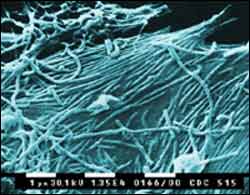Charting the path of the deadly Ebola virus in central Africa

Repeated outbreaks of the Zaire strain of the Ebola virus (Ebola virions pictured above) in central Africa were caused by a recent spread of the virus, rather than by a long-persistent strain at each site. (Photo: Walsh et al.)
Over the past ten years, separate outbreaks of the deadly Zaire strain of Ebola virus (ZEBOV) have killed hundreds of humans and tens of thousands of great apes in Gabon and the Republic of Congo–which harbor roughly 80% of the last remaining wild gorilla and chimpanzee populations. In a new study, Peter Walsh, Roman Biek, and Leslie Real combined genetic data with information on the timing and location of past ZEBOV outbreaks to support the hypothesis that a “consistently moving wave of ZEBOV infection” recently spread to outbreak sites in Gabon and Congo.
In the prevailing view, ZEBOV arose from long-persistent local strains after increased contact between humans or great apes and an unidentified reservoir host. But Walsh et al. found support for the alternative hypothesis: that ZEBOV had recently spread to the outbreak regions. This is good news because a virus that spreads at a predictable rate in a predictable direction is far easier to control than one that emerges by chance or at the hands of an unknown trigger. The authors modeled the virus’s spread based on assumptions of a long-persistent virus versus a recently emerged virus, and tested the predictions of these competing hypotheses using genetic data–gathered from gene sequences taken from human samples at the different outbreak sites–and information on the spatiotemporal dynamics of the outbreaks.
Though the strength of the individual lines of evidence is not conclusive when considered separately, taken together, they support the view that ZEBOV is spreading as a wave from the first epidemic in Yambuku, Gabon. Following its current course, ZEBOV may hit populated areas east of Odzala National Park within 1–2 years and reach most parks containing large populations of western gorillas in 3–6 years. Two Ebola outbreaks have already hit human populations west of Odzala, and over the past two years, the largest gorilla and chimp populations in the world, found in Odzala, have been devastated–the disease is spreading to the last unaffected sector of the park right now. These findings suggest that strategies to protect villagers and some of the last remaining wild apes from future outbreaks would do best to concentrate efforts at the front of the advancing wave–and start acting now.
Media Contact
All latest news from the category: Life Sciences and Chemistry
Articles and reports from the Life Sciences and chemistry area deal with applied and basic research into modern biology, chemistry and human medicine.
Valuable information can be found on a range of life sciences fields including bacteriology, biochemistry, bionics, bioinformatics, biophysics, biotechnology, genetics, geobotany, human biology, marine biology, microbiology, molecular biology, cellular biology, zoology, bioinorganic chemistry, microchemistry and environmental chemistry.
Newest articles

“Nanostitches” enable lighter and tougher composite materials
In research that may lead to next-generation airplanes and spacecraft, MIT engineers used carbon nanotubes to prevent cracking in multilayered composites. To save on fuel and reduce aircraft emissions, engineers…

Trash to treasure
Researchers turn metal waste into catalyst for hydrogen. Scientists have found a way to transform metal waste into a highly efficient catalyst to make hydrogen from water, a discovery that…

Real-time detection of infectious disease viruses
… by searching for molecular fingerprinting. A research team consisting of Professor Kyoung-Duck Park and Taeyoung Moon and Huitae Joo, PhD candidates, from the Department of Physics at Pohang University…





















